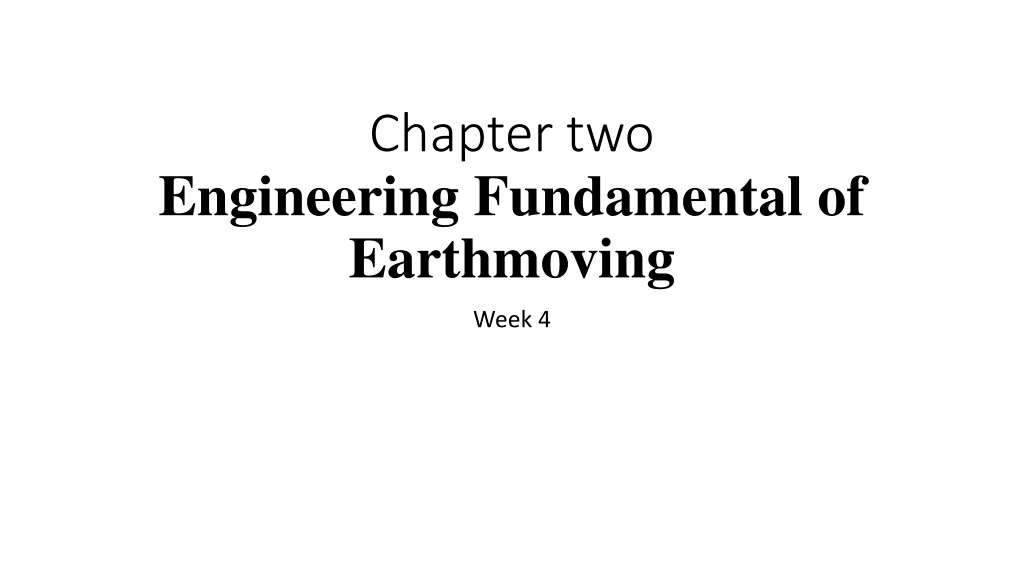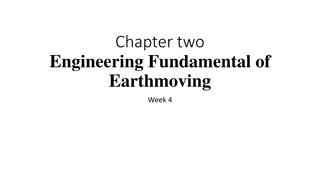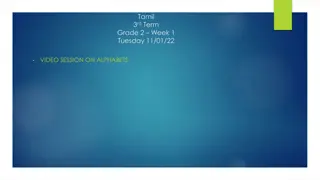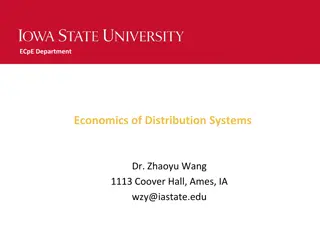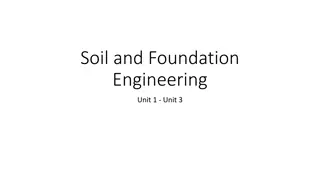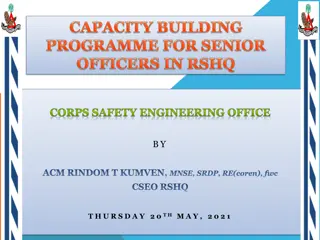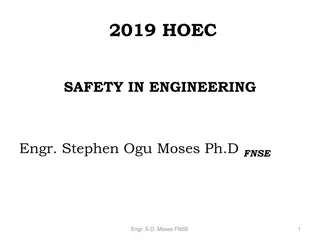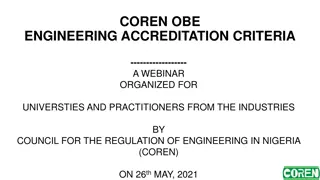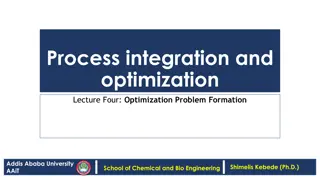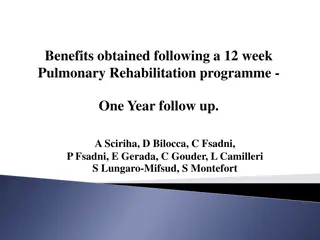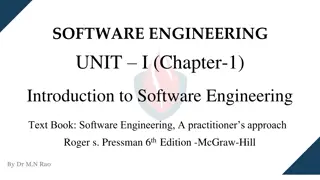Engineering Fundamentals of Earthmoving - Week 4 Insights
The content delves into various aspects of earthmoving operations in Week 4, covering topics such as hauling of materials, estimating equipment travel time, machine performance, required power, rolling resistance, and their impact on the productivity of machines involved in earthmoving activities.
Download Presentation

Please find below an Image/Link to download the presentation.
The content on the website is provided AS IS for your information and personal use only. It may not be sold, licensed, or shared on other websites without obtaining consent from the author. Download presentation by click this link. If you encounter any issues during the download, it is possible that the publisher has removed the file from their server.
E N D
Presentation Transcript
Chapter two Engineering Fundamental of Earthmoving Week 4
Hauling of Earthmoving Materials Hauling of Earthmoving Materials Loading: dozers and loaders Hauling: trucks and wagons
ESTIMATING AND EQUIPMENT TRAVEL TIME ESTIMATING AND EQUIPMENT TRAVEL TIME The time required for a haul unit to make one complete cycle (cycle time): Cycle time = Fixed time + Variable time
Machine performance Cycle time and payload determine a machine s production rate 1.requierd power 2.available power 3.usable power
Required power Required power The resistance of a level surface to constant velocity motion a cross it. This resistance varies considerably with the type and condition of the surface over which a vehicle moves.
For vehicles which move on rubber tires the rolling resistance varies with: 1. The size of tire. 2. The pressure of tire. 3. The tread design of tires. For crawler equipment the rolling resistance varies with: 1. The type of road surface. 2. The condition of road surface.
1.Rolling resistance 1.Rolling resistance Rolling resistance is expressed in kilograms of tractive pull required to move each gross ton over a level surface of the specified type or condition. For example, if a loaded truck having a gross weight equal to (20 tons) is moving over a level road whose rolling resistance is (45 kg/ton), the tractive effort required to keep the truck moving at a uniform speed will be:
example, if a loaded truck having a gross weight equal to (20 tons) is moving over a level road whose rolling resistance is (45 kg/ton), the tractive effort required to keep the truck moving at a uniform speed will be: Rolling resistance (kg) = Rolling resistance factor (kg/t) * Vehicle s weight (t) 20tons*45kg/tons=900kg
The rolling resistance factor increases about 15 kg for each 2.5 cm of tire penetration. This leads to the following equation for estimating rolling resistance factors: Rolling resistance factor (kg/t) = 20 kg/t + ( 6 x cm penetration) Table below provides typical values for the rolling resistance factor in construction situation.
typical values for the rolling resistance factor in construction situation.
2.Grade Resistance 2.Grade Resistance Grade resistance factor (kg/ t) = 10 x grade (%) A 1% grade (representing a rise of 1 unit in 100 units of horizontal distance) is considered to have a grade resistance equal to 1% of the vehicle s weight. This corresponds to a grade resistance factor of 10 kg/ t for each 1% of grade. Grade resistance (kg) = vehicle weight (t) x Grade resistance factor (kg/t)
Example (2-1): Find the effect of grade on the total tractive effort of a truck whose gross weight is (20 tons). The truck is moving up a road whose slope is (5%). Solution: The additional tractive effort resulting from the slope is: GR=20ton*5*10=1000kg Ans :kg 1000
Example (2-2): Find the effect of grade on the total tractive effort of a truck whose gross weight is (40 tons). The truck is moving up a road whose slope is (3%). Solution: The additional tractive effort resulting from the slope is: GR=40ton*3*10=1200kg If a tractor is towing a load, the combined gross weights of the tractor and its towed load should be used in determining the effect of grade.
Total resistance Total resistance Total resistance = Grade resistance + Rolling resistance
Example-(2-3) A wheel tractor-scraper weighing 91 t is being operated on a haul road with a tire penetration of 5 cm. what is the total resistance (kg) and effective grade when (a) the scraper is ascending a slope of 5%; (b) the scraper is descending a slope of 5%?
Rolling resistance factor = 20 + (6 x 5) = 50(kg/t) Rolling resistance = 50 x 91 = 4550 kg (a) Grade resistance = 91 x 5*10= 4550 kg Total resistance = Rolling resistance + Grade resistance = 4 550 + 4 550 = 9 100 kg
Effective grade = 5 + 50/ 10 = 10% (b) Grade resistance = 91 x 10 x (- 5) = - 4 550 kg Total resistance = - 4 550 + 4 550 = 0 kg Effective resistance = - 5 + 50/10 = 0%
Example:(2-4) A crawler tractor weighing 36 ton is towing a rubber-tired scraper weighing 45.5 t up a grade of 4%. What is the total resistance (kg) of the combination if the rolling resistance factor is 50kg/ton? Solution Rolling resistance factor = 50 kg/ton (given) Rolling resistance = 45.5 x 50 = 2275 kg Grade resistance = (36 + 45.5) x 10 x 4 = 3260 kg Total resistance = 2275 + 3 260 = 5535 kg
4.Effect of Traction 4.Effect of Traction The power available or needed to move a vehicle and its load is expressed as rimpull for wheel vehicles and drawbar pull for crawler tractors. Rim pull: is the pull available at the rim of the driving wheels under standard conditions, since it is assumed that no slippage of the tires on the rime will occur, the rim pull is also the power available at the surface of tires. R?? ????(??) =???.? ?? ?????????? ?????(??/??)
Where: V=velocity (km/hr) Hp=horse power Kg.m/sec E=efficiency The efficiency of most tractors and trucks will range from 80%to 85%
Example: its required to use a tractor on a road of a grade 4% and have a rolling resistance factor of 40kg/ton, what will be the netpull opposite to each gear. Tractor weight is 20ton,engine horse power equal to 200kg.m/sec. Gear 1 2 3 4 5 V(km/hr) 6.2 11.5 19 33 50
Solution: ??? ????(??) =???.? ?? ?????????? ?????(??/??) For gear 1 ??? ???? ?? =???.? ??? ?.?? = ?????? ?? ?? ?.? For gear 2 the same as gear 1
?.? = 40 20 = 800?? ?.? = 10 4 20 = 800?? ?.? = 1600?? Netpull=7463-1600=5863kg
Available power Gear 1 2 3 4 5 V(km/hr) 6.2 11.5 19 33 50 Rim pull 7463 4023 2435 1402 925 Net pull 5863 2423 835 -198 -675 Required power The tractor can do the job with gear 1,2,3
Drawbar pull: is the power available at the hitch of a crawler tractor operating under standard conditions. Maximum usable pull = Coefficient of traction * Weight on drivers.
Example (2-5): Assume that a rubber-tired tractor has a total weight of (18000 kg) on the two driving tires. The maximum rimpull in low gear is (9000 kg). If the tractor is operating in wet sand, with a coefficient of traction of (0.3): 1. Find the maximum possible rim pull prior to slippage of the tires. 2. Find the maximum possible rim pull prior to slippage of the tires, if the same tractor is operating on dry clay, with a coefficient of traction of (0.6).
Solution: For wet sand, the maximum possible rim pull prior to slippage of the tires will be: 0.3*18000=5400 Regardless of the power of the engine, not more than 5400 kg of tractive effort may be used because of the slippage of the wheels. 2. For dry clay, the maximum possible rim pull prior to slippage of the tires will be: 0.6*18000=10800 For this surface the engine will not be able to cause the tires to slip. Thus, the full power of the engine may be used.
Example (2-6): A crawler tractor whose weight is (15 tons) has a drawbar pull of (2000 kg) in sixth gear when operated on a level road having a rolling resistance of (50 kg/ton); if the same tractor is operated on another level road having a rolling resistance of (82 kg/ton) then: 1. Will the drawbar pull of the tractor be reduced or increased, find the effective drawbar pull? 2. If the road have a slope of (3%), what will the effective drawbar pull be, if the tractor moves: a) Up the road. b) Down the road.
1.The drawbar pull will be reduced because the rolling resistance is higher than the tested road. Drawbar pull= ? ?.? Drawbar pull=15 (82 50) = 480?? Effective drawbar pull=2000-480=1520kg
2. a) If the tractor was moving up the sloped road, the drawbar pull used to overcome the grade must be reduced from the original drawbar pull: Effective Drawbar pull=Pull-(Total resistance (G.R+R.R)) Grade resistance=(3) 10 15 = 450?? Effective drawbar pull=2000-(450+480)=1070kg
b. If the tractor was moving down the sloped road, then the drawbar pull will be added to the original drawbar pull: Effective Drawbar pull=Pull-(Total resistance (G.R+R.R)) Grade resistance=( 3) 10 15 = 450?? Effective drawbar pull=2000-(450-480)=1970kg
Example (2-7): A tractor whose weight is (12.4 tons) has a maximum rim pull in the first gear of (6228 kg), is operated up a haul road with a slope of (2%) and a rolling resistance of (45 kg/ton); determine the rim pull required for towing a load. Example (2-8): A wheel-type tractor with a (250 hp) engine weights (12.4 tons) has a maximum speed of (8Km/hr) in the first gear, is operated up a haul road with a slope of (2%) and a rolling resistance of (50 Kg/ton); determine the rim pull required for towing a load if the efficiency was 80%.
5.Effect of Altitude 5.Effect of Altitude All internal combustion engines lose power as their elevation above sea level increase because of the decreased density of air at higher elevations. Manufacturers use a derating factor to express percentage of reduction in rated vehicle power at various altitude. The following equation gives sufficiently accurate estimation for the derating factor: Derating factor (%) = [Altitude (m) 915]/102 The percentage of rated power available = 100 Derating factor
Example (2-9): A four-wheel-drive tractor weighs 20,000 kg and produces a maximum rimpull of 18160 kg at sea level. The tractor is being operated at an altitude of 3050 m on wet earth. A pull of 10,000 kg is required (total resistance) to move the tractor and its load. Can the tractor perform under these conditions?
Solution Derating factor = (3050 -915)/102 = 21% - Percent rated power available = 100 21 = 79% - Maximum available power = 18160 * 0.79 = 14346 kg From table 4-2, coefficient of traction = 0.45. - Maximum useable pull = 0.45 * 20000 = 9000 kg < 10,000 kg required to move the tractor.
Effective Grade Effective grade (%) = Grade (%) + (Rolling resistance factor (kg/t)) / 10 expressing total resistance is referred to as effective grade, equivalent grade, or percent total resistanceand is often used in manufacturers performance charts.
6.Gradabilty: maximum grade that vehicle can ascend ??????????? =??????? ?.? ?? ??????
Example (2.11): find the Gradability of a wheel tractor scraper of weight (35500kg) if it is Rimpull is 15000kg and rolling resistance is 50kg/ton. Solution: ?.? = 50??/? 35.5? = 1775?? 15000 0.85 = 12750?? ??? ?????? ??? ???? = ??????? (?.?)
??????? = 12750 1775 = 10975?? 10975 10 35.5= 31% ??????????? =
Example (2-10): A four-wheeled truck intended to be used in transporting earth material from site E to site F on a soft, rutted dirty road with +6% grade and 2990 m elevation. The soil density = 1.8 ton/m3, the truck capacity = 12 m3, the designed pull power for the truck = 14 ton, the coefficient of traction = 0 .45, and the truck weight = 10 ton. Find; A. The net pull for truck to be used for the job. C. The effective grade.
Solution A. Rolling resistance: From Table 2-1, find the rolling resistance factor for the truck = 75 kg/t The total weight = 10 + 1.8 * 12 = 31.6 ton Thus, the rolling resistance = 75 * 31.6 = 2370 kg Grade resistance = 10 * 6 * 31.6 = 1896 kg The total resistance = 2370 + 1896 = 4266 kg Derating factor = (2990 - 915)/ 102 = 20.34%. The net pull = 14000 * [(100 20.34)/100] 4266 = 6886.4 kg
b. The effective grade = Grade + (Rolling resistance factor/10) = 6 + (75/10) = 13.5%.
Example: a wheel tractor weight with the soil 40ton move on road of grade 5%and rolling resistance =100kg/ton according to the following data given for velocity of moving upward in table below. Find grade that the tractor cannot do the job. Gear 1 2 3 4 5 6 Velocity 3.2 4.1 5.5 6.2 7 11
Example: crawler tractor pulls a wheel scraper with the following data drawbar pull 12000kg weight tractor 20ton weight of scraper 40ton with soil rolling resistance for tractor 80kg/ton rolling resistance for scraper 120kg/ton considering 80%of the design pull only. Find the gradability of the tractor. ANS:7%
